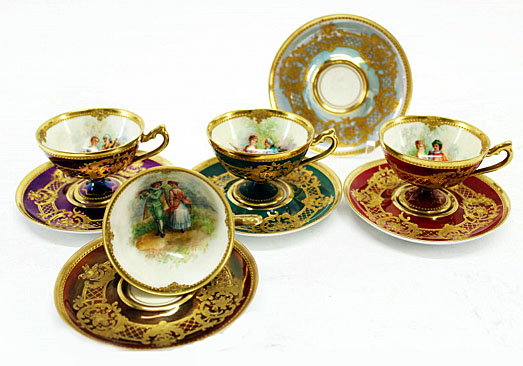 QUESTION: My grandfather left me the pocket watch he had received on his retirement. The watch is a Waltham. It still works but I’m not sure if it keeps good time. I already have a wristwatch and a smartphone, so I really don’t need this pocket watch. Is this watch collectible? If so, would it be a good idea for me to start a collection of them?
QUESTION: My grandfather left me the pocket watch he had received on his retirement. The watch is a Waltham. It still works but I’m not sure if it keeps good time. I already have a wristwatch and a smartphone, so I really don’t need this pocket watch. Is this watch collectible? If so, would it be a good idea for me to start a collection of them?
ANSWER: Your grandfather probably didn’t use his pocket watch very much. Businesses commonly gave gold pocket watches to members of their management staff upon their retirement. Before you do anything, you should take his watch to a watchmaker to have it checked and cleaned. Chances are, the watch is in like-new condition.
 Pocket watches date back to the early 16th century. German locksmith Peter Henlein from Nuremburg invented the first to portable timepiece. Henlein also invented a spring-driven mechanism which made the personal timepiece possible. Spiral springs could be wound and uncoiled to move the hour hand of the clock. However, this mechanism was highly inaccurate because coiled springs don't unwind at a constant speed. But having a timepiece people could or wear on a chain, even if it was off by an hour or so, was a great improvement.
Pocket watches date back to the early 16th century. German locksmith Peter Henlein from Nuremburg invented the first to portable timepiece. Henlein also invented a spring-driven mechanism which made the personal timepiece possible. Spiral springs could be wound and uncoiled to move the hour hand of the clock. However, this mechanism was highly inaccurate because coiled springs don't unwind at a constant speed. But having a timepiece people could or wear on a chain, even if it was off by an hour or so, was a great improvement.
However, Henlein’s portable clock had a heavy drum-shaped brass box-like case, typically four or five inches wide and abut three inches thick, take up too much space in a person’s pouch. Unfortunately, pickpockets could easily snatch a pouch worn outside a person's clothing, so cautious people began to hide their pocket clock inside their clothing. This proved to be uncomfortable, so people began wearing their clocks on a chain around their necks.
 By 1653, tailors had begun sewing small pockets called "fobs," from the German word fuppe, into the waistband of breeches, in which to carry a watch, money, or other valuables. The fob, which means to cheat or misrepresent, was meant to prevent any thief from easily removing a person's valuables.
By 1653, tailors had begun sewing small pockets called "fobs," from the German word fuppe, into the waistband of breeches, in which to carry a watch, money, or other valuables. The fob, which means to cheat or misrepresent, was meant to prevent any thief from easily removing a person's valuables.
By the end of the 18th Century, improvements in watchmaking resulted in watches that were thinner and more rounded. Tailors sewed smaller fob pockets into vests so that people could carry a watch attached to a chain.
 Early pocket watches only had an hour hand. The dial wasn’t covered with glass, but usually had a hinged brass cover, often decoratively pierced with grillwork so the time could be read without opening. Watchmakers created movements of iron or steel, held together with tapered pins and wedges, until after 1550 when screws appeared. Many of the movements included striking or alarm mechanisms. The shape of the watches soon evolved into a rounded form called Nuremberg eggs. And even later in the century a trend for unusually shaped watches, shaped like books, animals, fruit, stars, flowers, insects, crosses, and even skulls, became popular. Beginning in 1610, a glass crystal covered the watch dials. To wind and set the watch, the owner opened the back and fitted a key to a square arbor and turned it.
Early pocket watches only had an hour hand. The dial wasn’t covered with glass, but usually had a hinged brass cover, often decoratively pierced with grillwork so the time could be read without opening. Watchmakers created movements of iron or steel, held together with tapered pins and wedges, until after 1550 when screws appeared. Many of the movements included striking or alarm mechanisms. The shape of the watches soon evolved into a rounded form called Nuremberg eggs. And even later in the century a trend for unusually shaped watches, shaped like books, animals, fruit, stars, flowers, insects, crosses, and even skulls, became popular. Beginning in 1610, a glass crystal covered the watch dials. To wind and set the watch, the owner opened the back and fitted a key to a square arbor and turned it.
 The first solution to uneven unwinding came when watchmakers realized the spring uncoiled at a more constant pace when it wasn’t wound tightly. Watchmakers invented several ways to prevent this. The stackfreed was a cam with an additional spring that compensated for the main spring's changes in speed, and the fusee was a stop that prevented the spring from being wound too tightly. It was usually made of stiff hog bristle.
The first solution to uneven unwinding came when watchmakers realized the spring uncoiled at a more constant pace when it wasn’t wound tightly. Watchmakers invented several ways to prevent this. The stackfreed was a cam with an additional spring that compensated for the main spring's changes in speed, and the fusee was a stop that prevented the spring from being wound too tightly. It was usually made of stiff hog bristle.
 In 1675 several watchmakers discovered that a spiral spring attached to the balance greatly increased accuracy. Suddenly, watches reflected the correct time within minutes rather than being off by close to an hour. Until this time, watches had to be wound twice a day. A fourth wheel added to the movement decreased the winding required to once per day. Less than 100 years later, watchmakers added a hand to measure seconds. As years passed, people wanted calendars to mark the day, date and month, phases of the moon, as well as alarms, chimes and music.
In 1675 several watchmakers discovered that a spiral spring attached to the balance greatly increased accuracy. Suddenly, watches reflected the correct time within minutes rather than being off by close to an hour. Until this time, watches had to be wound twice a day. A fourth wheel added to the movement decreased the winding required to once per day. Less than 100 years later, watchmakers added a hand to measure seconds. As years passed, people wanted calendars to mark the day, date and month, phases of the moon, as well as alarms, chimes and music.
 Early pocket watches had no covering to protect the face or the hour hand. In the 18th century English watchmakers began creating gold and silver cases to slide the watch into to protect it. Watchmakers added glass crystals to protect the dial around 1610 but because they were translucent, people still had to remove them to read the time.
Early pocket watches had no covering to protect the face or the hour hand. In the 18th century English watchmakers began creating gold and silver cases to slide the watch into to protect it. Watchmakers added glass crystals to protect the dial around 1610 but because they were translucent, people still had to remove them to read the time.
English watchmakers added jewels, usually second-rate gemstones in the 18th century as bearings in the watches to prevent friction and wear between metal parts. However, watchmakers from other countries didn’t adopt "jeweling" for nearly another 100 years. Today, the number of jewels a watch has is a sign of its quality and durability. Most pocket watches have between 7 and 21 jewels.
 Pocket watches came in either of two types of cases—hunting or open-faced. Hunting case watches, popular during the 19th century, have a spring-hinged circular metal lid or cover, that closes over the watch-dial and crystal, protecting them from dust, scratches and other damage or debris, and opens when the owner pushes a button. Most antique hunter-case watches have the lid-hinges at the 9 o'clock position and the stem and crown of the watch at the 3 o'clock position. By 1900, the open face watch took over and hunting case watches became less commonplace. Watchmakers made cases of silver and gold. Many were gold-filled, with two thin sheets of gold on the outside around a thicker layer of brass. They also used a variety of silver-colored material, with names like silveride, usually nickel based.
Pocket watches came in either of two types of cases—hunting or open-faced. Hunting case watches, popular during the 19th century, have a spring-hinged circular metal lid or cover, that closes over the watch-dial and crystal, protecting them from dust, scratches and other damage or debris, and opens when the owner pushes a button. Most antique hunter-case watches have the lid-hinges at the 9 o'clock position and the stem and crown of the watch at the 3 o'clock position. By 1900, the open face watch took over and hunting case watches became less commonplace. Watchmakers made cases of silver and gold. Many were gold-filled, with two thin sheets of gold on the outside around a thicker layer of brass. They also used a variety of silver-colored material, with names like silveride, usually nickel based.
Waltham pocket watches are very collectible. But because watch designs changed often in the early years, they sometimes made only a few of some models. A good example is the Waltham Model Appleton, a size 20, 18-carat gold watch with a rear key wind that had sold for $10,000. Because so many were made and in such variety, collectors can buy a pocket watch in running condition from as low as $100 US up to the $1000s if you want. Since most pocket watches don’t appreciate much in value, it’s possible to start a modest collection on a limited budget.
To read more articles on antiques, please visit the Antiques Articles section of my Web site. And to stay up to the minute on antiques and collectibles, please join the over 30,000 readers by following my free online magazine, #TheAntiquesAlmanac. Learn more about "The Vernacular Style" in the 2024 Winter Edition, online now. And to read daily posts about unique objects from the past and their histories, like the #Antiques and More Collection on Facebook.












































